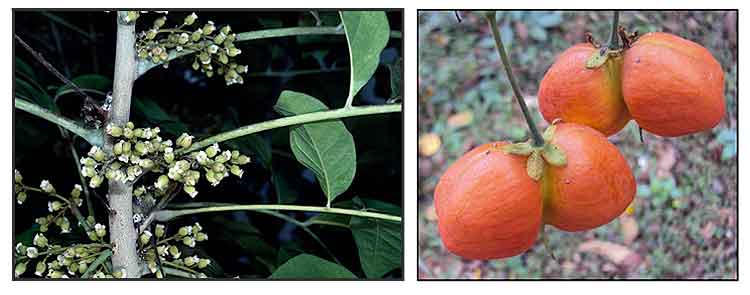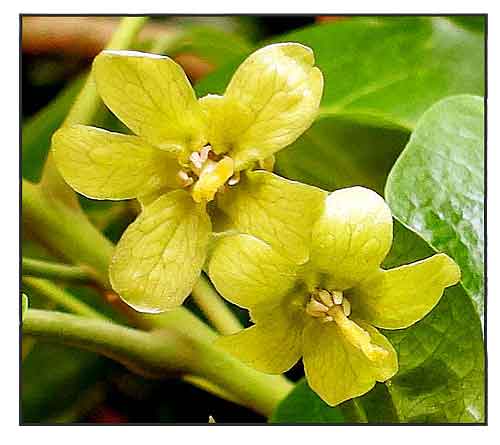
Gen info
- Harpullia is a genus of about 27 species of small to medium-sized forest trees. Plants in the genus are usually dioecious shrubs or trees covered with simple or star-shaped hairs. (13)
- The genus Harpullia was first formally described by William Roxburgh in his Flora Indica.
- Etymology: The genus name Hapullia is derived from harpulli, the common name of Harpullia cupanioides (the type species). (13)
The specific epithet arborea means "tree-like".
- Taxonomy: The species was first formally described in 1837 by Francisco Manuel Blanco who named it Ptelea arborea in his Flora de Filipinas. In 1887, Ludwig Adolph Timotheus Radlkofer transfered the species to Harpullia as H. arborea. (14)
 Botany Botany
• Uas is a tree that reaches a height of about 20 meters. Leaves are alternate, 10 to 30 centimeters long, with 5 to 9 leaflets. Leaflets are smooth, oblong or broadly lanceolate, 7 to 15 centimeters long, about 5 centimeters wide, the tip being pointed and the base blunt and oblique. Flowers are small, greenish, borne on panicles arising from the upper leaf axils. Fruit is inflated, smooth, yellowish-red, dehiscent, about 1.5 centimeters long and 2.5 centimeters wide, and divided into two lobes, each containing a few seeds.
• Harpullia arborea is a tree that typically grows to a height of up to 30 m (98 ft), sometimes to 40 m (130 ft), with a trunk dbh of 60–70 cm (24–28 in), its branchlets covered with woolly brown hairs. Its leaves are paripinnate, 40–220 mm (1.6–8.7 in) long with 6 to 10 elliptic to egg-shaped leaflets with the narrower end towards the base, mostly 100–190 mm (3.9–7.5 in) long and 40–75 mm (1.6–3.0 in) wide on a petiole 40–90 mm (1.6–3.5 in) long. Separate male and female flowers are borne on the same plant, usually in racemes in leaf axils, sometimes on old wood, and are 40–220 mm (1.6–8.7 in) long. Each flower is on a pedicel 10–50 mm (0.39–1.97 in) long. Sepals are 6–7 mm (0.24–0.28 in) long and covered with woolly hairs. The petals are pink or pale green and 12–14 mm (0.47–0.55 in) long, there are 5 stamens, and the ovary is covered with soft hairs. The fruit is a broadly heart-shaped, orange-yellow to red capsule 15–23 mm (0.59–0.91 in) long, containing shiny black seeds.
Distribution
- Native to the Philippines.
-
Common in thickets and second-growth forests at low and medium altitudes throughout the Philippines.
- Also native to Assam, Bangladesh, Borneo, Cambodia, Fiji, India, Jawa, Lesser Sunda Is., Malaya, Maluku, Nepal, New Guinea, Queensland, Samoa, Solomon Is., Sri Lanka, Sulawesi, Sumatera, Thailand, Tonga, Vanuatu, Vietnam.

- Seeds yielded glycosides, steroids, saponins, and resins.
(See study below) (1)
- Study of leaves isolated a new horhopane triterpenoid, 3ß-eicosanoyl-6ß-hydroxy-21αH-24-norhopan-4(23),22(29)-diene. (7)
- Phytochemical screening of various seed extracts yielded the presence of glycosides, steroids, saponins, and resins. (see study below) (9)
- Study of leaves yielded a new triterpenoid, 3beta-eicosanoyl-6beta-hydroxy-21alphaH-24-norhopa-4(23),22(29)-diene, together with a lupane-type triterpenoid, lupeol; a sterol, alpha-spinasterol and an inositol derivative, quebrachitol. (see study below) (10)
- Analysis of leaf essential oil yielded 47 chemical constituents with antioxidant properties. Major constituents of EO included phytol and
(E)-ß-ionone. (16)
Properties
- Studies have suggested antioxidant, antibacterial, lymphocyte stimulatory, antifungal properties.
Parts used
Bark, fruit, seeds.
Uses
Edibility
- No report on edibility.
- Probably inedible. (see below: Soap)
Folkloric
- Bark is pounded and used as a substitute for gogo (Entada phaseoloides).
- Watery exudate from bark and fruit used to prevent leech bites.
- Oil of seed sometimes used as anti-rheumatic.
- Fruit extract with coconut oil and castor oil used for digestive problems and as appetizer.
- In Kerala, India,
bark, fruits, and seeds used by ethnic communities as leech repellent, hair wash, and anti-rheumatic. (1) (11)
- In Sri Lanka, used for snake bites. (12)
- In Tamil Nadu, seeds sold as anthelmintic. Formulation Perali ennai containing fruit of H. arborea used as appetizer and cure of digestive problems. (5)
Others
- Wood: Heartwood is yellow brown. Wood is hard, medium weak to medium heavy, shrinking little on drying. Used for high quality cabinet work and furniture, plywood, packing boxes, etc. (17)
-
Fish poison: Finely chopped bark placed on fresh-water streams to kill fish.
- Repellent: In Kerala, India, bark and fruits used as leech repellent.
- Soap: Pounded bark, sometimes the fruit, used as a substitute for soap. (17)
Studies
• Antibacterial / Seeds: Phytochemical screening of seeds yielded glycosides, steroids, saponins, and resins. Extracts showed inhibitory activity against Bacillus subtilis, Salmonella typhi, Pseudomonas aeruginosa, E. coli, and Proteus vulgaris. The methanol extract was more potent than the aqueous extract. (1)
• Leaves / Quebrachitol / Stimulatory Effect on Lymphocyte Proliferation: Phytochemical study of leaves yielded a a new triterpenoid, 3beta-eicosanoyl-6beta-hydroxy-21alphaH-24-norhopa-4(23),22(29)-diene, together with a lupane-type triterpenoid, lupeol; a sterol, alpha-spinasterol and an inositol derivative, quebrachitol. A methanol extract and quebrachitol exhibited in vivo stimulatory effect on lymphocyte proliferation. (2)
• Antiradical / Antibacterial / Antifungal / Leaves:Study evaluated the antiradical and antimicrobial potential of H. arborea extract of macerated leaves. Results showed concentration dependent scavenging of radicals with potent scavenging activity against ABTS radicals (IC50 4.26 µg/ml) compared to DPPH radicals (IC50 27.26 µg/ml). The extract showed inhibitory activity against all test bacteria, with marked activity against Staphylococcus epidermis. There was also considerable reduction of mycelial growth with highest inhibition to Curvularia sp. (5)
• Inhibitory Against Seed-Borne Fungi:Study evaluated the antifungal potential of methanolic extract of leaves of two plants viz., Harpullia arborea and Hydnocarpus pentandra against seven seed-borne fungi. Marked antifungal activity was displayed by H. arborea compared to H. pentandra, with Aspergillus niger showing greatest inhibition. Results showed both plant have potential to inhibit seed mycoflora. In suitable formulations, they can be used against in the management of seed-borne fungal diseases of plants. (6)
• Antimicrobial Against Food Isolates /
Bark: Study evaluated the antibacterial activity of H. arborea bark extracts against food isolates. Among the solvent extracts, methanol extracts showed good inhibitory activity against gram positive and gram negative isolates, with zones of inhibition ranging from 10 mm to 18 mm. Results showed potential as natural alternative preventives to control food isolates. (8)
• Antibacterial / Seeds: Study evaluated the antimicrobial activity of crude methanol and aqueous extracts of seeds against standard strains and clinical isolates of bacteria. Results showed inhibitory activity against clinical isolated of Bacillus subtilis, Salmonella typhi, Pseudomonas aeruginosa, Escherichia coli and Proteus mirabilis. The methanol extract showed more potent activity than the aqueous extract. (see constituents above) (9)
• Antifungal / Inhibitory against Seed-Borne Fungi / Leaves: Study evaluated the antifungal potential of methanolic leaves extracts of Harpullia arborea and Hydnocarpus pentandra against 7 seed-borne fungi. Poisoned food technique was used to determine antifungal activity. Both extracts were effective in inhibiting mycelial growth in a concentration dependent manner. Marked antifungal activity was shown by H. arborea compared to H. pentandra. Aspergillus niger and Penicillium sp. were inhibited to highest and least extent respectively by both extracts. (10)
•
Silver Nanoparticles / Antibacterial / Antioxidant / Bark: Study reports on the synthesis of AgNPs using H. arborea bark extract and evaluated their efficacy against food borne pathogens using agar well disc diffusion method. Results showed antibacterial activity against bacterial isolates with the AgNPs showing higher antimicrobial potency than non AgNPs. Lowest MIC was recorded against Staphylococcus aureus (3.5 mg), followed by Enterococcus faecalis and Pseudomonas aeruginosa (4.5 mg). DPPH assay showed similar antioxidant activity to ascorbic acid. Results suggest potential commercial use as antimicrobial and antioxidant. (15)
• Anti-Hepatitis C / Leaves: Study evaluated the anti-HCV activity of H. arborea leaves extract and isolated compound against JFH1a and J6/JFH1 in a cell culture using Huh7 cells. Results showed leaves extract exhibited anti-HCV activity with IC50 of 17.5 µg/ml and 12.4 µg/ml against JFH1a and J6/JFH1 respectively. Stem extract showed no activity. The butanol fraction at 30 µg/ml inhibited HCV JFH1a growth by 54%, compared to other fractions at 15-30%. The anti-HCV activity could be due to synergism of various compounds. The specific compound has yet to be identified. (17)
Availability
Wild-crafted.
Seeds in the cybermarket.
|

![]()






